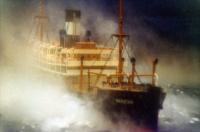The Waratah 1908 - 29 July 1909
 Source: Daily Dispatch
Source: Daily Dispatch
The SS Waratah, sometimes referred to as "Australia's Titanic", was a 500 foot steamer. In July 1909, the ship, en route from Durban to Cape Town, disappeared with 211 passengers and crew aboard. The disappearance of the ship remains one of the most baffling nautical mysteries of all time. To this day no trace of the ship has ever been found.
According to Dispatch archives, the 10 000 ton ship passed along the Transkei coast on July 28, 1909 after stopping off in Durban the previous day.
It was heading to London and would have stopped over in Cape Town before setting sail on the high seas. A Dispatch report from July 1971 said: “Two people had disembarked in Durban – one to find a job and the other after he dreamt that the ship would sink – and after being spotted by two other ships along the Transkei coast, the Waratah disappeared in what was to become ‘one of the most baffling nautical mysteries of all time’.”
 ;As it sailed past the Transkei coast, between the mouths of the Bashee and Xora rivers, the ship is said to have encountered bad weather and battled to sail against high winds, a combination of tide and turbulent ocean swell.
;As it sailed past the Transkei coast, between the mouths of the Bashee and Xora rivers, the ship is said to have encountered bad weather and battled to sail against high winds, a combination of tide and turbulent ocean swell.
Carrying provisions on board to last a year, the Waratah is said to have fallen victim to a freak wave, capsized and been sucked to the ocean floor with all aboard. In the 100 years since it disappeared various theories have tried to explain its demise.
Numerous attempts to salvage it and a few sightings have been reported, with none proving to be true. A world genealogy website reports initial theories suggested it remained adrift for a while and was carried away from the southern African shoreline and drifted into the Antarctic Circle where passengers and crew died of cold and starvation, the ship itself eventually being crushed to pieces in the southern ice.
“Another possibility was that the ship blew up because of an explosion due to heating of her bunker coal, bringing a quick and painful death to all on board,” the website reports.
Agreeing with the theory that the ship went down in a storm, Smit said debris wasn’t found because everything was secured tightly when the storm hit.
He said the ship was either deliberately steered away from the coast to avoid it bashing onto rocks, or it was driven away from the shore by the current, and swept past the southern African tip away from the coastline. “Since they found the Titanic, why can’t they find the Waratah,” Smit asked. - By NTANDO MAKHUBU
More info: Wikipedia

Comments
david pells (not verified)
Sun, 04/11/2012 - 17:56
Permalink
waratah
camdenham
Mon, 05/11/2012 - 02:59
Permalink
Waratha 4
Cheif Engineer'... (not verified)
Sun, 13/01/2013 - 20:38
Permalink
Chief Engineer's point of view
ANDREW (not verified)
Sun, 03/03/2013 - 11:34
Permalink
WARATAH
david pells (not verified)
Sun, 03/03/2013 - 12:05
Permalink
waratah
ANDREW (not verified)
Sun, 03/03/2013 - 14:11
Permalink
Hi David, You make a very
Kevin (not verified)
Mon, 31/03/2014 - 09:12
Permalink
Bath(y)metry of the Continental Shelf
ANDREW (not verified)
Mon, 31/03/2014 - 10:08
Permalink
continental shelf off Port St Johns
Gary Pressman (not verified)
Mon, 08/04/2013 - 13:47
Permalink
Waratah,The perfect storm.
Anonymous (not verified)
Tue, 24/09/2013 - 13:40
Permalink
waratah position
Add new comment